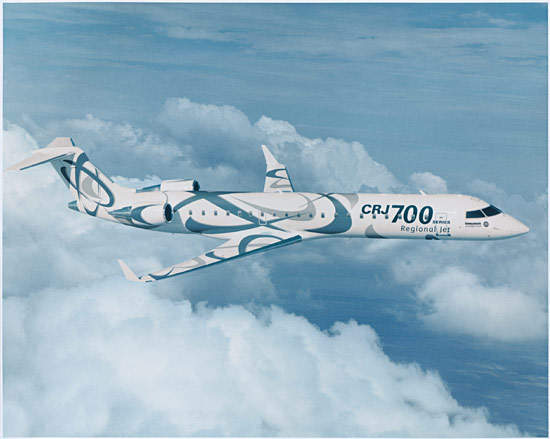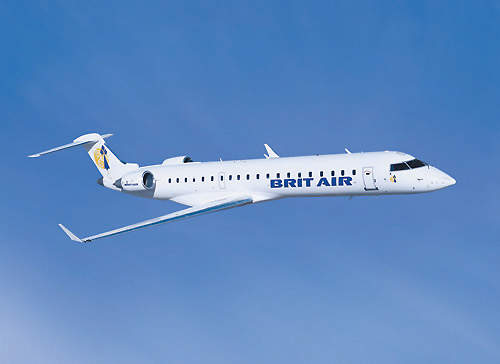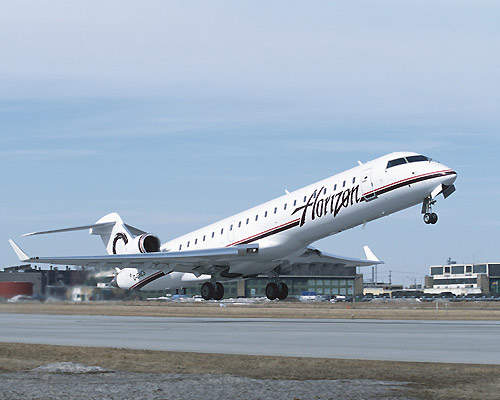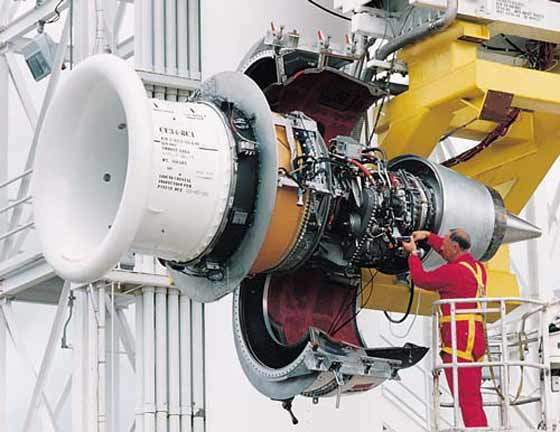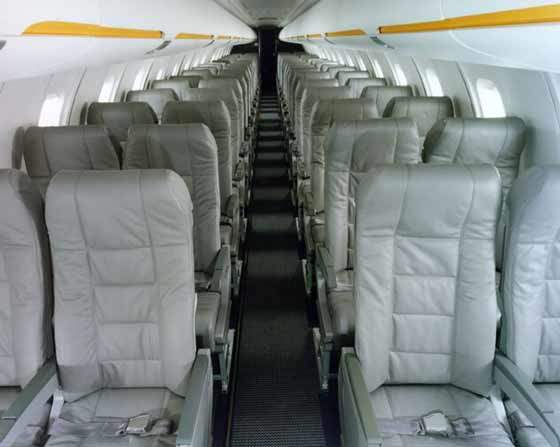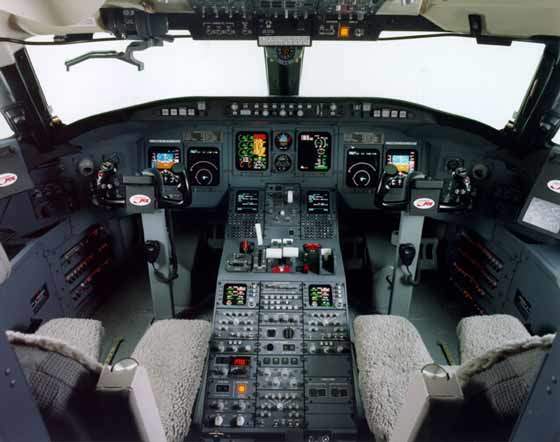The Bombardier Canadair Regional Jet CRJ700 is a 70 to 78-seat variation of the CRJ regional jet family. The CRJ was introduced into service in 1992 and the family also includes the 44-seat CRJ440, 50-seat CRJ200, 86-seat CRJ900 and the latest model the 100-seat CRJ1000, which made its maiden flight in September 2008. Total firm orders for the CRJ family are for more than 1,660 aircraft. The 1,500th aircraft of the CRJ family was delivered in March 2008.
Bombardier launched the CRJ700 in 1997 and the first flight and roll out took place in May 1999. The CRJ700 entered service in February 2001 and the aircraft has 322 firm orders. More than 270 aircraft have been delivered.
The CRJ700 is in service with Brit Air (launch customer), Horizon Air, Delta Connection Inc (Atlantic Southeast Airlines and Comair), Mesa Air and American Eagle, Sky West (52 plus 60 options), Air Canada (30) in North America, Lufthansa Cityline, Maersk Air Ltd in Europe and Shandong Airlines of China.
Recent orders include: GoJet Airlines (ten plus 40 options) and Mesa Air Group (ten).
Sky West (with partner Atlantic South-East Airlines) is the largest operator of CRJ aircraft with a fleet of 363 aircraft, including 102 CRJ700. The airline placed an order for an additional 18 CRJ700 and four CRJ900 NextGen aircraft in November 2007. Sky West placed four more aircraft orders in January 2011.
The regional aircraft division of Bombardier Aerospace, based in Toronto, Ontario, is responsible for marketing, sales, contracts and product support for the CRJ series jet airliners. The company’s training facilities include the Bombardier Aerospace Training Center in Montreal and a facility in Berlin, Germany, operated under agreement between Lufthansa, CAE and Bombardier Aerospace.
In March 2005, Bombardier announced the introduction a new long-range (LR) variant of the CRJ700. The CRJ700 LR has a range of 4,048km and an increased maximum take-off weight, allowing it to carry more fuel. The aircraft is powered by General Electric CF34-8C5B1 engines, a variation of the engine used on the CRJ900.
In June 2005, Bombardier delivered the first of a new variant, the 75-seat CRJ705, to Air Canada Jazz. The CRJ705 has a range of 3,773km and a maximum take-off weight of 38,330kg.
In May 2005, Bombardier launched the Challenger 870, a corporate shuttle based on the CRJ700. The Challenger 870 accommodates 70 passengers in a standard cabin, 44 in split cabin and 42 in deluxe cabin configuration. The aircraft entered service in March 2006.
In May 2007, Bombardier announced the CRJ NextGen family aircraft, which have new cabin interiors, including larger passenger windows, more baggage space and LED lighting. There is also increased use of resin transfer moulding (RTM) composites in the aircraft construction with reduced fuel consumption.
The first NextGen aircraft, the 75 to 90-seat CRJ900 NextGen, entered service with Northwest Airlines in June 2007. The 66 to 68-seat CRJ700 NextGen is scheduled to enter service in 2008 and the 86 to 100 seats CRJ1000 NextGen in 2009. As of July 2011, 312 CRJ700 aircraft were delivered.
Bombardier’s maintenance facility in Dallas, Texas, began repair and maintenance services for CRJ700 aircraft in April 2011.
CRJ700 design features
The CRJ700 is a stretched version of the 50-seat CRJ200, its length being increased by 5.74m. It also has a wingspan increased by 2m and an increased internal cabin width.
The wing has leading edge slats to improve lift. The nacelles have been redesigned for the more powerful engines and the landing gear upgraded. The fuselage is of semi monocoque design.
The CRJ700 is a very quiet aircraft (with an operational take-off noise level of 89EPNdb) and is very fuel efficient, with a range of 3,674km and fuel capacity of 9,017kg.
The assembly and interior fit of the aircraft is carried out at the Bombardier Canadair manufacturing facility at Dorval in Quebec.
Bombardier Canadair is responsible for the manufacture of the flight deck, wings, rudder, the electrical systems and primary flight control systems. Mitsubishi Heavy Industries manufactures the rear section of the fuselage. The aircraft is fitted with Avcop vertical and horizontal stabilisers and GKN, in the UK, manufactures the tail cone and doors.
Flight deck and cabin on the Bombardier Canadair Regional Jet
The two pilot flight deck is fitted with a Collins Pro Line 4 six-tube electronic flight and information system (EFIS) and an engine indication and crew alerting system (EICAS).
The aircraft is equipped with a Flight Dynamics HGS 2000 head-up display and guidance system, a Rockwell Collins automatic heading reference system (AHRS), a terrain collision avoidance system (TCAS) and a Rockwell Collins digital weather radar. The integrated avionics processor integrates the autopilot and flight management systems.
The Flight Dynamics HGS 4200 head-up guidance system was certified for the CRJ700 in September 2002. The system allows CAT III approach and landing down to 200m runway visual range (RVR) and lower-than-standard CAT I approaches down to 450m (RVR).
The main cabin, by C&D Interiors, is nearly 21m in length with a centre-line width of 2.57m and can seat up to 70 passengers. It is a spacious aircraft with two-by-two seating and provides more than 6ft 2in of standing headroom.
The rear baggage compartment and under floor baggage compartment provide a total baggage space of 23.33m³. The cabins are air-conditioned with a Liebherr air management system and the lighting system is supplied by Hella.
Turbofan engines of the CRJ regional jet family aircraft
The aircraft has two General Electric CF34-8C1 turbofan engines providing 56.4kN thrust at take-off and 61.3kN thrust, with auto power reserve power.
From mid-2005, production aircraft were fitted with the upgraded CF34-8C5B1 engine, providing 58.4kN thrust at take-off, 63.4kN with auto power reserve.
The engine nacelles mounted on either side of the rear section of the fuselage were developed and supplied by Bombardier Aerospace (Shorts Brothers) of Belfast.
There are two integral wing fuel tanks, with a fuel capacity of 11,488l. The Intertechnique fuel management system is fitted with Ratier – Figeac controls.
Electrical power is provided by a Hamilton Sundstrand electrical generator, with two integrated drive generators providing 40kVA. The Honeywell auxiliary power unit is installed in the tailcone. The aircraft is fitted with a Walter Kidde fire detection system.
Landing gear of Bombardier’s Canadair Regional Jet CRJ700
The aircraft is fitted with Menasco Aerospace hydraulically retractable tricycle-type landing gear. The aircraft are fitted with Parker and Abex Hydraulics systems.

